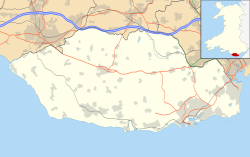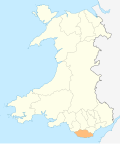| Aberthin | |
|---|---|
 Aberthin | |
Location within the Vale of Glamorgan | |
| OS grid reference | ST008752 |
| Community | |
| Principal area | |
| Preserved county | |
| Country | Wales |
| Sovereign state | United Kingdom |
| Post town | Cowbridge |
| Postcode district | CF71 |
| Police | South Wales |
| Fire | South Wales |
| Ambulance | Welsh |
| UK Parliament | |
| Senedd Cymru – Welsh Parliament | |
Aberthin is a small village, just outside Cowbridge in the Vale of Glamorgan, South Wales, on the north side of a shallow valley, less than a mile northeast of Cowbridge across the A48 road. [1] Cowbridge Comprehensive School lies just to the southwest of the village. About 250 metres to the south is an old quarry, with a "faulted strip of grey oolite". [2] Aberthin is also the name of a brook, the River Aberthin. [3] The village was served by the Aberthin Platform railway station between 1905 and 1920, now a field to the west of Aberthin.



